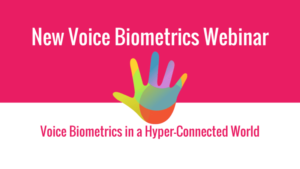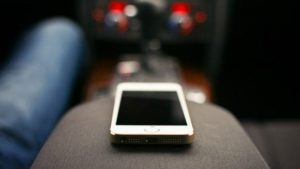On account of its flexible, software based nature, voice recognition technology is incredibly versatile in terms of potential applications. Identifying and authenticating a user via the unique qualities of her voice is contactless, quick, and easy to deploy in any scenario where a microphone is available. Here are four unique examples of voice biometrics in action that illustrate the spoken authentication modality’s various strengths:
- Solving Crimes With Voice Recognition
 When it comes to a crime scene the cliche is to dust for fingerprints or swab for DNA samples, but that’s not the only detritus criminals can leave behind. There are some forensics situations in which only audio evidence is available to investigators, and that’s where voice biometrics can be deployed to great effect.
When it comes to a crime scene the cliche is to dust for fingerprints or swab for DNA samples, but that’s not the only detritus criminals can leave behind. There are some forensics situations in which only audio evidence is available to investigators, and that’s where voice biometrics can be deployed to great effect.
Early last year, Morpho (Safran) partnered with voice biometrics specialist AGNITIO to bring Voice ID technology into its multimodal suite of criminal identification products. Requiring only seconds to perform matching on live or recorded voices, and boasting an accuracy rating of over 99 percent, Voice ID brings a new angle to forensic investigations.
What’s most impressive about Voice ID, and what makes it incredibly well suited to the world of forensics, is its language agnostic nature. AGNITIO’s technology measures the biological traits that are expressed through the sound of a subject’s voice rather than the shape and pattern of her speech. This means that regardless of whether police are looking for a French fraudster or an English extortionist, Voice ID can do its job.
- Letting Your Voice Protect Your Bank Account

As mentioned previously during Voice Biometrics Month 2016, voice biometrics is often paired with facial recognition to bolster a multi-factor system. In combination with face biometrics, voice recognition can act as an additional authentication factor as well as a built-in liveness detection test—the logic being that while speaking for authentication, the face recognition software can see your mouth moving. Because this specific combination of modalities is software based, it is often seen built in to banking apps.
One such banking app is Wells Fargo’s Commercial Electronic Office (CEO) app, which recently won a Monarch Innovation Award thanks in large part to its biometric security. In addition to standalone eye-vein biometrics, the CEO app leverages SpeechPro’s multimodal VoiceKey.OnePass solution. VoiceKey.OnePass combines the two contactless factors of voice and face to great effect, enabling any mobile device with a front facing camera and microphone to ditch passwords in favor of more secure and convenient authentication.
- Buying Products and Services With The Sound of Your Voice
 One of the most popular and mainstream applications of biometrics in general is mobile payments, and voice recognition has also made its way into this highly competitive arena. Biometrics company VoiceVault, in partnership with Bay Area startup SayPay Technologies, has brought voice authentication to mobile commerce. The company’s ViGo mobile voice biometrics platform was integrated with SayPay’s eponymous technology last year, aiming to bring convenient security to card-not-present payment transactions.
One of the most popular and mainstream applications of biometrics in general is mobile payments, and voice recognition has also made its way into this highly competitive arena. Biometrics company VoiceVault, in partnership with Bay Area startup SayPay Technologies, has brought voice authentication to mobile commerce. The company’s ViGo mobile voice biometrics platform was integrated with SayPay’s eponymous technology last year, aiming to bring convenient security to card-not-present payment transactions.
Instead of using PIN or password security to authenticate transactions, SayPay has users speak a one-time-password. This combines the OTP token security with the ease of use offered by a vocal interface. Going a step further, the randomized nature of the passwords thwarts presentation attacks by design. While a static voice code might be vulnerable to a fraudster with a tape recording, this spoken OTP technique is much more secure.
- A Handsfree AI Assistant That Knows Who You Are
 If you have an iPhone with the latest iOS, you also have voice recognition software in the form of its famous AI assistant, Siri. While the primary use of Apple’s AI persona is based around voice command—users saying something and having the software respond in kind—a recent upgrade has moved Siri in to the realm of user identity and authentication.
If you have an iPhone with the latest iOS, you also have voice recognition software in the form of its famous AI assistant, Siri. While the primary use of Apple’s AI persona is based around voice command—users saying something and having the software respond in kind—a recent upgrade has moved Siri in to the realm of user identity and authentication.
Late last year, Apple upgraded Siri to also support voice recognition. The aim was to make Siri capable of discriminating between your own voice and the speech of others. On new iPhones only the device’s authorized user can activate Siri, asking her to perform tasks, answer questions, or tell jokes. Furthermore, the inclusion of voice recognition on Siri has also opened up the possibility of voice-based unlock for the iPhone, allowing users who prefer to go hands free a biometric security feature of their own.
*
Stay posted to FindBiometrics throughout May as we continue to examine the featured topic of voice biometrics. Participate in the conversation by following us on Twitter.
Voice Biometric Month 2016 is made possible by our sponsors AGNITIO and SpeechPro.
—
May 18, 2016 – by Peter B. Counter


Follow Us